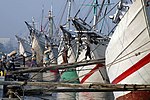Maritime Museum (Indonesia)

The Maritime Museum (Indonesian: Museum Bahari) is located in the old Sunda Kelapa harbor area in Penjaringan Administrative Village, Penjaringan Subdistrict, Jakarta, Indonesia. The museum was inaugurated inside the former Dutch East India Company warehouses. The museum focuses on the maritime history of Indonesia and the importance of the sea to the economy of present-day Indonesia. The museum displays models of fishing boats and other maritime objects from different parts of Indonesia. The museum also exhibits the celebrated Pinisi schooners of the Bugis people of South Sulawesi, which at present make up one of the last sea-going sailing fleets in the world. In January 2018, much of the museum was destroyed by a fire. The goods inside the burnt museum was evacuated later than from the fire. The cause of the fire was caused by the due to electric short circuit.
Excerpt from the Wikipedia article Maritime Museum (Indonesia) (License: CC BY-SA 3.0, Authors, Images).Maritime Museum (Indonesia)
Kali Besar Timur, Special Capital Region of Jakarta Tambora (West Jakarta)
Geographical coordinates (GPS) Address Nearby Places Show on map
Geographical coordinates (GPS)
| Latitude | Longitude |
|---|---|
| N -6.1269833333333 ° | E 106.8083 ° |
Address
Kota Tua Jakarta
Kali Besar Timur
11110 Special Capital Region of Jakarta, Tambora (West Jakarta)
Indonesia
Open on Google Maps










